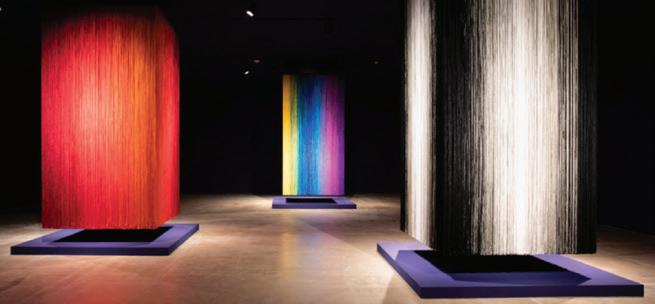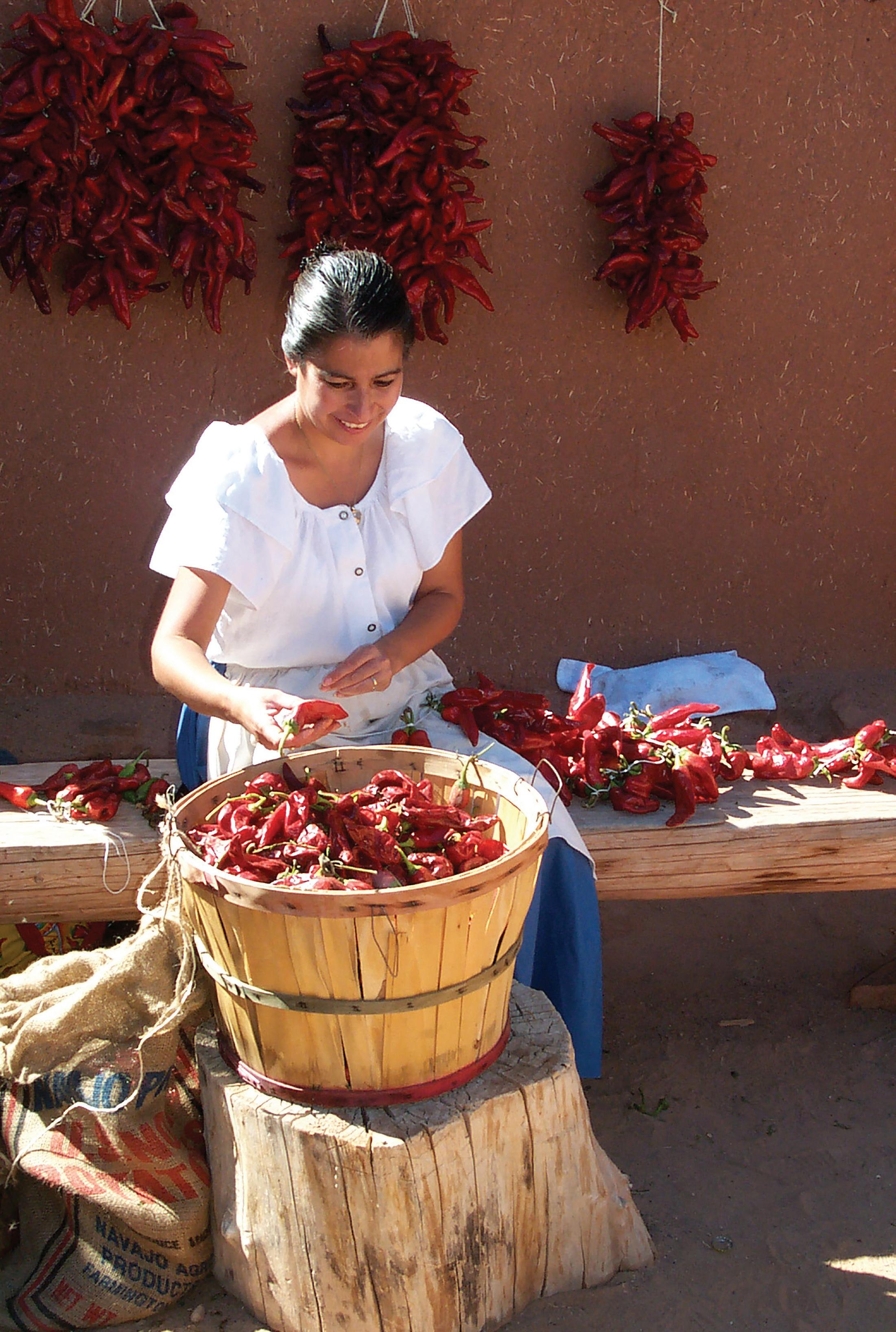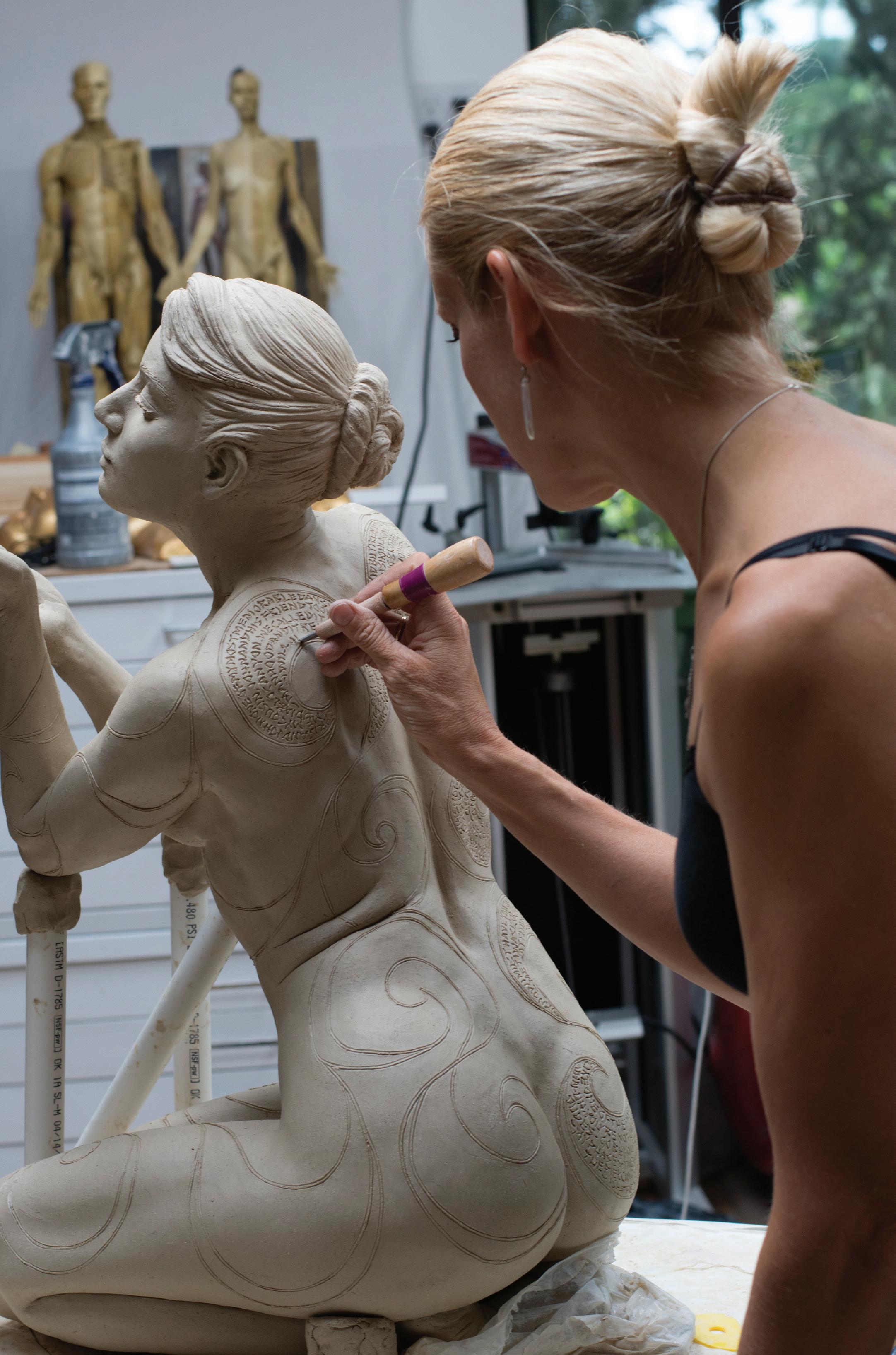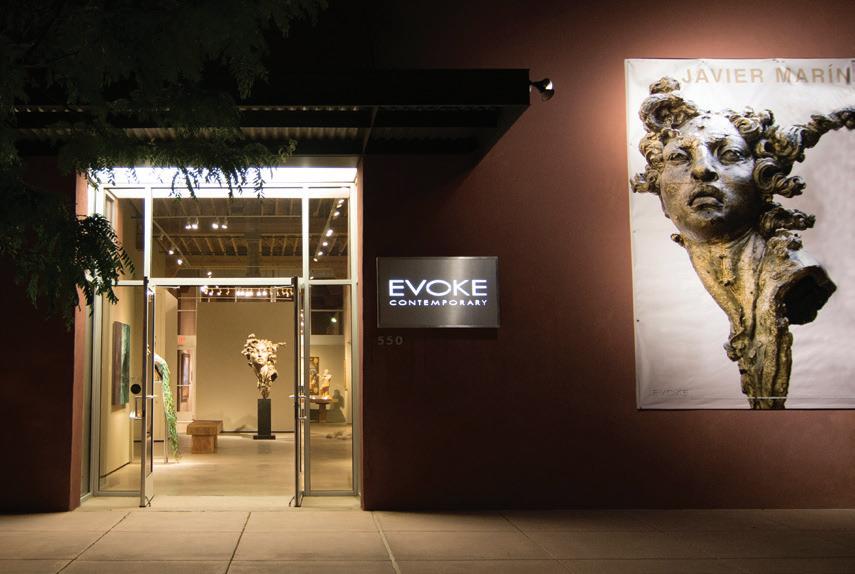
7 minute read
Oil of Joy: Louisa McElwain
Above: Louisa McElwain, Sound the Trumpets, 2012, oil on canvas, 44” x 44”. Opposite: Louisa McElwain painting in Abiquiú, September 2012.
One day in 2011, I was walking with artist Louisa McElwain through the galleries of the Phoenix Art Museum. As curator of American and European art, I had acquired one of her works for the museum’s collection and had just installed an exhibition of contemporary Western art that included four McElwain paintings. We stopped to look at a naturalistic landscape by one of her contemporaries, its highly detailed image quite different from her own loose, painterly style. McElwain looked closely and talked about the precision of the composition. She then scrunched up her brow, squinted, moved one palm up near her face, and with her other hand began to “paint” tiny imaginary marks on her palm, as if she were holding a small canvas. “Working like this,” she stated, “this isn’t art. This is a headache.” She then opened her eyes wide. “THIS!” she proclaimed, swinging her arms in big windmill motions—“This is art!” Of course, her statement was about more than making art. It was her pronouncement of how everything—all of “THIS!”— is connected, and that it all goes into making art and living an artistic life. McElwain’s paintings tie together her love of nature and the outdoors, her religious beliefs and strong political opinions, her appreciation for food and music, and her adoration for the great vistas found in the high desert of New Mexico. Born in 1953 in New Hampshire, in 1985 she moved to New Mexico,


Above: Louisa McElwain, Sundown, Ghost Ranch, 1999, oil on canvas, 44” x 72”. Opposite: Louisa McElwain, O Prima Vox, 2007, oil on canvas, 54” x 72”.
where she lived on a small farm not far from Santa Fe until her sudden death, in 2013, at age 59. For McElwain, all that she did was intertwined—her paintings are only part of the larger whole.
I remember that conversation at the Phoenix Art Museum vividly, because the energy and excitement McElwain expressed spoke directly of her approach to art and life. The motions of her arms, though exaggerated in the moment, indicated her actual painting technique, which required not only keen dexterity of hand and mind, but also the engagement of her entire body. Working on site, she would tie large canvases to an apparatus built onto the back of her pickup truck, using the tailgate to hold her palette and paints. Instead of brushes, McElwain used palette knives or carpentry trowels duct-taped to the end of a pole to extend her reach—as she applied heavy layers of paint to her canvas, she looked like a fencer thrusting a saber. She would set out a pool of white paint, then separate out a bit at a time to mix with different colors, which she then added to her canvas. She worked quickly, the actions of her mixing colors and applying paint creating surfaces of thick impasto.
McElwain’s paintings express a vibrancy, an almost electric energy. For example, in O Prima Vox (2007) we see storm clouds gathering in the early New Mexican evening sky. The setting looks across Abiquiú Lake and the distinctively flat-topped Cerro Pedernal. Earlier, Georgia O’Keeffe had painted Pedernal multiple times, and once declared, “It’s my private mountain. It belongs to me. God told me if I painted it enough, I could have it.” To tackle such an iconic image so closely associated with another artist, one must have faith in one’s own convictions. In McElwain’s rendition, we find a radically different approach to O’Keeffe’s cool, smooth style. McElwain used slashes and smears of color atop color, almost as if attempting to sculpt the landscape with pronounced slabs of pigment.
Up close, areas in O Prima Vox appear as abstract designs that would be at home on a nonrepresentational canvas by Willem de Kooning. Colors collide, blend, and bleed through one another. To see the painting as a landscape requires taking a step back from it. The essence of the setting sun is found in the brilliant yellow and orange forming along the distant hills and shining off the upper sections of the cloud formations. The lower areas of clouds, however, are dark and slightly ominous.
This sumptuously colorful, awe-inspiring view speaks to the power of nature, and suggests—in sentiment if not in style— American landscapes of the 19th century. We see not just a majestic depiction of God in nature, but an expression that God is nature, the “first voice” of the painting’s title. Every square inch is alive. It recalls the impressive compositions of earlier artists such as Albert Bierstadt, Frederic Edwin Church, and Thomas Cole. With its storm on the left, calmer skies on the right, and a lake that appears more like a meandering river, O Prima Vox brings to mind the Hudson River School. Although separated from that tradition by nearly two centuries, McElwain’s painting is connected to those past works through the reverence the artists had for the land itself.
McElwain’s strong use of color is also developed in Sundown, Ghost Ranch (1999), its subject another specific place made famous by O’Keeffe. Undulating forms in varying shades of purple, maroon, green, blue, and yellow make up the foreground. We can see how the paint was applied through a series of quick motions in varying directions. The design is made vibrant by the addition of small curves, squiggles, and dashes of pigment, along with incisions made with the edge of a palette knife that cut through paint layers. Above this are the exposed strata of the rising cliff face of a high mesa. Despite the energetic depiction of the land, the central portion



Top to bottom: Louisa McElwain, Desert Cloudburst, 2007, oil on canvas, 44” x 52”. Louisa McElwain, Navajo, 2005, oil on canvas, 54” x 62”. of the sun-drenched cliff face and lush wedge of blue sky to the left ultimately comprise a tranquil work that conveys the region’s sublime beauty.
About 300 miles west of Ghost Ranch is Monument Valley, located within the Navajo Nation along the Arizona-Utah border. The area has visually defined the West in popular culture through its use in many motion pictures, including Stagecoach (1939) and Forrest Gump (1994). Nevertheless, it can be challenging for painters to capture its grandeur, as the sandstone buttes are spread across roughly five square miles and require distance to be included in a single vista. In Navajo (2005), McElwain shows us the monumental formations from many miles away. With a low horizon, attention is instead given to the big sky and large, detached cumulus clouds. The work evokes the repeating and stylized flat-bottomed clouds in Maynard Dixon’s Western landscape painting Cloud World (1925). In Navajo, however, variation within the billowing clouds excites the scene. The high wind currents and rising cool air that produce such clouds are visualized by paint swirls of white and gray created by McElwain’s sweeps of the palette knife. The clouds cast large shadows on the land below, including the foreground, thus placing viewers under a cloud to make us part of the scene.
Clouds are a prominent subject in McElwain’s work. Both Sage of Worlds (2001) and Desert Cloudburst (2007) belong to a series of paintings that show various stages of cumulonimbus clouds forming into rainclouds. The clouds seem in motion, at times releasing sheets of rain across an open expanse before darkened mountains. The cloud series are among McElwain’s strongest compositions—one

Above: Louisa McElwain, Sage of Worlds, 2001, oil on canvas, 56 x 72”.
was acquired by the Phoenix Art Museum—and in looking at these paintings, the viewer experiences the artist’s presence in nature. We can appreciate the energy it took to make Sage of Worlds and Desert Cloudburst: McElwain standing behind her truck, using big arm movements to sweep paint across the canvas with a trowel at the end of a pole as winds gusted, clouds formed, and rain began to fall. Her dance with nature, time, changing light, and the elements often resulted in dirt, twigs, and bugs being embedded in the surfaces of her large paintings. As she would say, they are “extreme paintings.”
Louisa McElwain was an exceptional artist who beautifully blended the traditions of early landscape art with the bravado of abstract expressionism. Her bold paintings of the American Southwest are grand expressions of an awe-inspiring love of nature. More than a window on the outdoors, her works offer visually immersive experiences that reveal her complete engagement with the natural world. Through her art, we glimpse the passionate individual who created them.
—Jerry N. Smith, PhD









